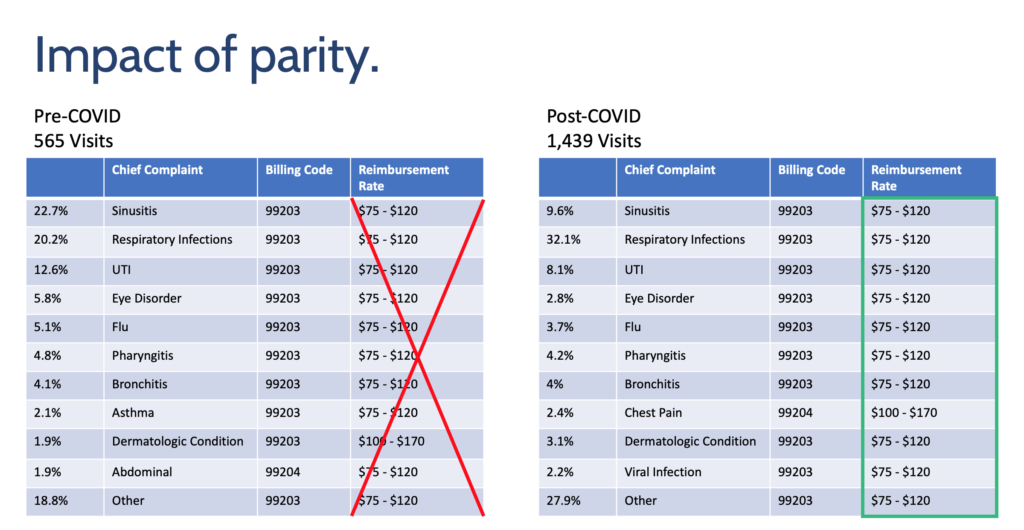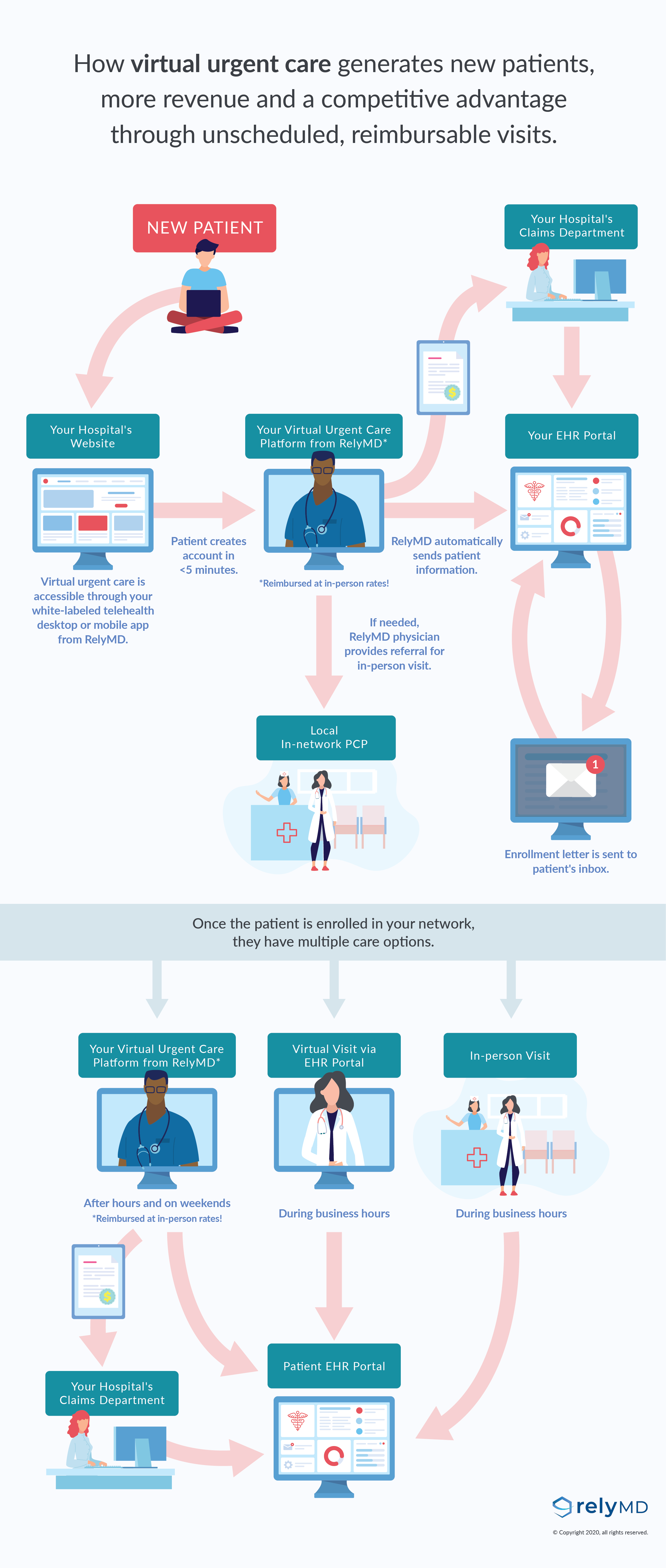
Patient experience, better healthcare outcomes, and gaining a competitive advantage are all virtual visit benefits. But if you haven’t considered using a telemedicine platform for revenue generation, you could be missing out. A major component and justification for providing on-demand virtual care service to your patient population is the impact it can have on your bottom line.
The most profitable type of telemedicine platform is one that can serve your patients with on-demand virtual care, a telehealth service that is available 24/7, to both new and existing patients. No appointments are necessary and visits can be completed from start to finish in as little as 10 minutes, it’s an incredibly convenient option for patients needing care now. This is not to be confused with virtual primary care, an equally important service for established patients wanting remote care from their regular provider.
There are two types of revenue a telemedicine platform can help provide, immediate and downstream revenue, and luckily the both happen simultaneously once you’ve deployed an on-demand virtual care service.
How a telemedicine platform contributes to immediate revenue
A telemedicine platform used for any type of visit (primary care, urgent, inpatient, etc) contributes to immediate revenue through the cost per visit, just like a normal in-person visit. However, your state’s parity policies will dictate just how much revenue you can expect to capture for virtual visits (along with your contracts with payer partners). While many states are still not up to date on payment parity, the COVID-19 pandemic has pushed to expand regulatory rules and long-term changes across the country are under the microscope with positive changes expected to take place permanently. Learn about your state’s parity policies here.
Due to these temporary changes, since March 2019, providers can expect to collect reimbursements at near in-person rates no matter where they’re located. In a recent webinar, we examined the pre- and post-COVID visits typically seen by a health system’s virtual care providers. You can quickly see how these changes have resulted in a significant increase in immediate revenue which were previously missed due to outdated regulations in the state of North Carolina.
The below chart will also be helpful to you to determine how many of these symptoms and medical conditions are treated within your facilities and can instead be easily monitored and treated remotely.

While telemedicine platforms used for on-demand virtual care services can be accessed by existing patients, they’re best considered as a patient acquisition tool. Patients local to your health system can easily register and log in to receive care from your network without the need of an existing patient portal account. Attaching your locally recognized brand can help establish comfort and trustability when patients are comparing your on-demand service to generic vendors without a hospital affiliation.
As more and more patients seek remote care to avoid unnecessary exposures to the coronavirus and other diseases, telehealth visits have skyrocketed. Hospitals and health systems using this to their advantage can expect to see more patient acquisition through online channels than ever before. Those with telehealth platforms that can cater to digitally savvy patients have an even greater opportunity to capture immediate revenue with an abundance of visits and generous reimbursement payments. With data and patient information captured at the time of visit within the telemedicine platform, it’s also easier than ever before.
How a telemedicine platform contributes to downstream revenue
As described above, immediate revenue generated from telemedicine platforms can be done so through a variety of visit types. Depending on the CPT code used, immediate revenue can range from $75 to $250 per visit. However, downstream revenue is primarily attributed to on-demand virtual care services.
Each time you capture a new patient through your virtual urgent care service, you have a chance to turn them into a loyal patient who drives additional revenue. According to the Advisory Board, 20% of virtual care patients can be expected to generate $3,000 in annual downstream revenue.
From March 15 – June 1, 2020, a North Carolina health system saw a significant increase in virtual care patients that equated to treating over 1,500 patients remotely. Taking in the Advisory Board’s analysis, over the course of these three months this health system can expect to see over $900,000 in annual downstream revenue. As telehealth visits are expected to remain at a higher than normal rate, the health system can expect to see that number remain steady throughout the remainder of the year.
It’s important to note that not all telemedicine platforms are created equal for downstream revenue generation. The integration of your health system’s specialty care facilities into your telemedicine platform’s referral network is key to creating patient engagement, especially for new patients. Virtual health is just one channel for healthcare and using it as a piece of your referral strategy helps patients navigate primary and specialty care facilities when there is a need for in-person care. Whether they need to establish a primary care physician or obtain a referral to an ENT based on symptoms obtained by your virtual care provider, you should expect to rely on your telemedicine platform to drive these positive engagements, and ultimately downstream revenue.
Take a look at the following infographic that shows how a new patient starts as an on-demand virtual care patient and quickly transforms to a loyal patient who relies on a health system for multiple types of healthcare, all done through a telemedicine platform built for generating revenue.

Generating revenue with the right telemedicine platform
Relying on telemedicine platforms disconnected from your overall healthcare network will surely leave you feeling letdown as patients use the service and quickly leave without additional direction on how to seek follow-on care. They’ll leave their additional care needs in the hands of Google and will be inundated with a variety of choices that give them the easiest path to additional services, dismissing the importance of patient continuity. Patients want connected healthcare, make it easy for them to navigate your healthcare network with virtual care powered by care coordination.
Get in Touch
5665 NEW NORTHSIDE DR STE 320
Atlanta, GA, 30328
855-955-0948


